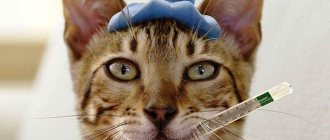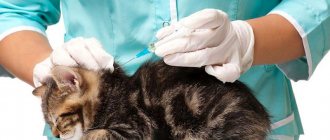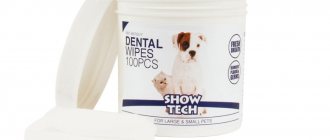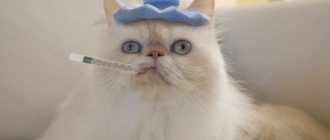Anastasia Dmitrievna Mitryaykina
veterinarian Petstory
Normal temperature in cats is one of the most important indicators of health. Changes in body temperature, up or down, can significantly affect your pet's health, and sometimes the consequences can be fatal.
- Heat
Symptoms of fever in a cat
Common symptoms of fever in a cat that warrant taking the animal's temperature are:
- lethargy;
- refusal of food;
- hot nose or ears;
- rapid breathing;
- cardiopalmus;
- diarrhea;
- vomit.
Symptoms of low body temperature are:
- severe lethargy
- food refusal
- shiver;
- cold parts of the body, such as the pads of the feet, signs of chills;
- convulsions.
Table with standards
| T/age | Up to 10 days | 10–30 days | month–10 years | Older |
| 35–37 | norm | normal/reduced | downgraded | downgraded |
| 37–38 | normal/increased | norm | downgraded | reduced/normal |
| 38–39 | Promoted | increased/normal | norm | norm |
| more than 39 | Promoted | increased | increased | increased |
How to bring down or increase the temperature
If a cat's body temperature increases or decreases, in order to temporarily alleviate its physiological condition, it is possible, depending on the situation, to lower or increase the temperature.
Attention! There is no treatment for temperature as such; temperature is only a symptom indicating the presence of pathology in the animal’s body.
In order to bring down the temperature, you need to wrap the cat in a damp, cold towel, give it a cold drink (slightly below room temperature), put it in a cool place without drafts, but under no circumstances on a concrete floor or ground. If the temperature rises due to illness, it is necessary to urgently begin treatment for the disease and take a course of IV drips to reduce the temperature.
A pet with hyperthermia should never be given fever-reducing medications intended for humans.
First aid for fever is to wrap the animal in a cold, wet towel and take it to the clinic. Drinking water must be available at all times.
To increase the temperature, the cat must be placed on a warm heating pad, and bottles of warm water wrapped in a rag should be placed next to it (to prevent burns). Give a warm drink. If a decrease in temperature occurs against the background of a disease, immediately begin treatment and raise the temperature in a veterinary clinic.
First aid for a low temperature is to put the cat on a heating pad, give him warm water to drink and take him to the clinic.
Factors affecting temperature
Age
Before the age of 10 days (neonatal period), kittens cannot independently maintain their body temperature. They are heated by the warmth of the mother or other external sources (heating pads). The normal body temperature of a newborn kitten is from 35 to 36 degrees, but it also directly depends on the temperature in the nest.
If there is no mother, or for some reason she does not care for the offspring, the owner will have to take care of the babies. Place heating pads in the nest. If it is electric, then select the weakest mode on it. If you place water in a bottle, then its temperature should be about 40 degrees. Cover the bottle with several layers of blankets. If you are using a red lamp, it is important to place the thermometer at the warmest point. The temperature should not exceed 30 degrees, otherwise the babies may overheat.
By the age of one month, a kitten’s temperature of 38 degrees is considered normal. Further, adult animals have a normal temperature; it can fluctuate depending on various factors, but always remains within the range of 37.5–39 degrees. Older pets tend to be less active and their body temperature rarely exceeds 38 degrees Celsius.
Activity
In general, if a furry couch potato is calm, its temperature will be lower than that of an active and cheerful cat, such as an Abyssinian or Burmese breed.
Times of Day
In the morning the result is usually lower than in the afternoon. The cat is a twilight predator, and all its vital processes occur more actively in the evening.
Overweight
Overweight animals usually have a lower body temperature than moderately well-fed animals.
Body temperature after sterilization or castration
In the first hours after sterilization and castration, male cats may experience a decrease in body temperature, most often this occurs after sterilization.
After sterilization or castration, the animal must be returned from the veterinary clinic with a temperature of 37.8-39 degrees.
If, after being discharged from the veterinary clinic, the operated pet has a sharp drop or rise in temperature, this is a reason to immediately contact the veterinary clinic. Thus, various postoperative complications may occur.
Causes of elevated temperature
global $ads_google;
//data-ad-slot=”2475549904″ $ads_google = empty($ads_google) ? false : true; ?> if ($ads_google == false) {?> $ads_google = true; ?> } ?> Hyperthermia has its own causes: most often these are diseases caused by viruses or bacteria. For a small kitten, an increase in body temperature of 2 degrees can be fatal. In children, the cause of exceeding the indicator is sometimes worms.
In addition to viral and bacterial infections, the list of causes includes poisoning from stale food, and even excess salts in the body. Due to excess salts, the breakdown of proteins and tissues begins.
Parasites poison the body with toxins, to which the immune system responds by increasing temperature levels.
Medicinal causes include the body’s reaction to the administration of substances that excite thermoregulation centers in the brain.
Fever can be subfebrile (excess of 1 °C above normal), febrile (2 °C), hyperpyretic (over 3 °C).
The temperature rises slightly during exercise, eating and pregnancy.
How to measure a cat's temperature
There are two ways to measure a cat's temperature: rectally or through the ear canal.
The temperature is measured rectally with a regular mercury or electronic thermometer, having previously lubricated it with liniment.
Disadvantages of using a mercury thermometer:
- duration of the measurement procedure (7 - 10 minutes) - due to stress, the animal’s temperature may increase, which may distort the objectivity of the obtained indicators;
- fragility of a mercury thermometer - an animal, especially an aggressive one, can break free during the thermometry process, break the thermometer and injure itself.
Taking this into account, in most cases, veterinarians use electronic thermometers specially designed for this method of thermometry to measure rectal temperature.
To measure a cat's temperature rectally, use a special bag - a clamp, or take measurements as follows:
- During the thermometry process, it is advisable to keep the animal together;
- the pet is fixed under the arm, with all four paws placed on a hard surface;
- the thermometer is smoothly inserted rectally to a depth of no more than 2 cm, strictly at an angle of 90 degrees;
- measurement duration is 2-3 minutes with an electronic thermometer, or 7-10 minutes with a mercury thermometer.
You can also measure a cat’s temperature through the ear canal using an infrared non-contact thermometer, but due to the relatively high cost of this device, this method of thermometry is not yet very widespread.
Is it necessary to bring down the high temperature?
If the values are critical, before the veterinarian arrives (when calling at home), you can try to reduce the temperature:
- give plenty of fluids;
- moisten the wool with cool water;
- Place a damp cloth or some ice in the groin folds.
You should not give your cat antipyretic drugs intended for humans (Aspirin, etc.). They can aggravate the animal's condition and lead to its death. The pet should be treated in accordance with the recommendations of a specialist.
Measuring with a thermometer
As we wrote above, the only accurate method for determining temperature is measurement with a thermometer. For animals, two types of thermometers are usually used: ear and rectal. The earphone is a convenient modern device that is much easier to use. But still, the rectal one is most often used, since for measurements in this case a regular children's model of an electronic thermometer can be used.
How exactly do you take a rectal measurement? The procedure will require two people. One will take measurements, the second will hold the animal and calm it down. If this is standard procedure for your cat, then most likely she will not resist. And if you are doing this for the first time, difficulties may arise. If the animal is aggressive, it is better not to carry out the procedure, as the pet may injure itself and you.
So, take a thermometer. Treat the tip with alcohol, and then lubricate it with Vaseline. Lift the cat's tail and insert the thermometer into the hole using a screwing motion. The insertion depth should be about 2 cm. Now your task is to hold the thermometer until accurate data is obtained. Sometimes after the sound signal you need to hold the thermometer for about 30 seconds and remove it only when the temperature stops rising. Now evaluate the result and wipe the thermometer with alcohol again.
How to measure the temperature in the ear? First you need to calm the animal, show it the thermometer, and give it a sniff. Next, you can take measurements. In principle, even one person can do this. Wipe the tip of the thermometer, carefully insert the thermometer into the ear, but not very deeply. Now wait for the signal and add a few more seconds until the temperature stops rising. Take out the thermometer and wipe it again with alcohol.
Thermoregulation of cats
Thermoregulation is the ability of animals to maintain body temperature within the most suitable range for life, even if the ambient temperature differs significantly. Cats are mammals. To determine the surrounding temperature, they, like other representatives of this group, have special sensitive organs located in the skin - these are cold and heat receptors.
A receptor is a sensitive nerve ending or specialized cell that converts perceived stimulation into nerve impulses, which, in turn, transmit information to the brain.
The number of cold and heat receptors in cats is not the same. There are much more of the first, and they are not very deep in relation to the surface of the skin; heat receptors are located deeper. This is why almost all cats love warmth and only in extreme heat do they prefer cool places.
Cold receptors are closer to the surface of the skin than heat receptors
Cats have several ways to maintain normal body temperature:
- Sweating. Cats don't sweat like people. There are few sweat glands on their body, and they are not able to remove enough fluid from the body to maintain normal body temperature. Therefore, cats cannot effectively get rid of “excess” heat in this way.
- Licking. For a cat, this is not just a sign of cleanliness, but a necessary procedure for maintaining thermal balance. When licking, a moisture-repellent layer is formed on the fur, which helps maintain the desired body temperature. This procedure also stimulates the glands located deep in the skin, which secrete a special substance - sebum. It reduces the amount of ultraviolet rays penetrating the skin and slows down the release of moisture from the surface of the skin without preventing air from entering. Sebum protects the animal well from moisture and temperature fluctuations in the environment. In winter, licking helps cats retain heat, and in summer, it increases heat transfer by increasing the space between the fur hairs, which opens up air flow to the skin.
- Acceleration of breathing. The main way cats increase heat output. As the air temperature rises, the cat begins to breathe more often. From the outside it looks like shortness of breath: the mouth is open, breathing is shallow. Under normal temperature conditions, a cat makes approximately 30 inhalations/exhalations per minute; in hot weather, their number increases several times.
When severely overheated, a cat begins to breathe with an open mouth, which increases heat transfer in the body.
The listed cooling methods are not always enough. It happens that the best way to avoid overheating is to simply go into the shade. This is what cats do if their health worsens due to the heat.
There are breeds that are more prone to overheating, such as longhaired breeds. They experience heatstroke faster.
Changing body position allows cats to both increase heat transfer and retain heat. For example, in the summer you can often see whiskered animals lying stretched out in the sun, and animals behave the same way near the radiator in winter. But as soon as it gets cooler, the cat immediately curls up into a ball.
Like other mammals, cats can retain body heat by contracting small blood vessels in the skin: in the cold, the vessels narrow, and heat transfer decreases; in heat, they expand, and heat transfer, accordingly, increases. In addition, cats can fluff up, thus increasing in volume. The air gap formed in this case reduces heat loss, and the cat does not freeze. Hairless cats have a more difficult time in this regard; in the cold they freeze very quickly.
By fluffing up its fur, a cat reduces heat loss
The methods of heat regulation described above apply more to adult cats. Kittens do not immediately become capable of independent thermoregulation. At temperatures below 18°C, children may freeze.
First aid for a cat at home
Normalizing body temperature does not cure the underlying disease, but improves the pet’s general condition and prevents the development of complications. A critical increase in temperature changes leads to damage to vital organs and systems and disruption of their functions. At home, before visiting a doctor, you can only use physical methods to lower or raise the temperature - cooling measures and warming, as appropriate.
It is unacceptable to lower your cat's temperature with medications on your own.
Antipyretic drugs, which are practically safe for humans, can lead to intoxication of the cat’s body, so their use is possible only as prescribed by a veterinarian. It is strictly forbidden to treat a cat with antipyretics and painkillers of the anilide group (paracetamol, Panadol, Tylenol, Efferalgan, acetaminophen and others) - they lead to severe hematopoietic disorders and the death of the animal.
First aid for hyperthermia
Cooling measures are required for cats with temperatures above 39.4-40°C; at lower temperatures they can lead to hypothermia. In case of heat injury, one of the most effective methods of cooling is wetting the fur and then placing the animal under a powerful fan. You can alleviate the condition at elevated temperatures with ice packs - they are applied to the inner surface of the thighs and neck. This method is convenient for emergency transportation of a pet to a veterinarian. If there is no constipation, diarrhea, or acute abdominal pain, cold water enemas will help reduce the temperature. Another way to eliminate hyperthermia is to wet the paw pads with alcohol.
Ice covering the entire body and general cold baths are not recommended. They cause a narrowing of peripheral vessels, which contributes to the flow of “overheated” blood to the internal organs and their further damage.
If the temperature drop is insignificant, it is enough to wrap the cat in a blanket
First aid for hypothermia
For a cat with a slight (up to 32.2°C) decrease in temperature without signs of exhaustion, it is enough to wrap it in a blanket, after drying the wet fur with a towel or hairdryer. If the animal is exhausted or the previous method is ineffective, warm air is blown under the blanket with a hairdryer, and it is better to wrap the animal’s head as well. With a more pronounced decrease in temperature, the animal is covered with bottles of warm water and taken to the clinic.
If a cat that has been exposed to the cold for a long time does not show signs of life, it should be examined by a veterinarian - during an amateurish examination, a living pet in this state is often mistaken for dead. Cats with severe hypothermia should be transported to the clinic carefully, protecting them from shocks - even the slightest mechanical impact can lead to cardiac arrest and death.
In kittens under 3 weeks of age growing up without a mother, their body temperature drops even when kept in a relatively warm room - their body is able to maintain a temperature only 5-7°C above the environment. The nest of such babies should be kept warm at least 29-32°C. The space inside the box can be heated with lamps, hot water bottles wrapped in a towel.
Learning to measure a cat’s temperature and knowing what its changes may be associated with is important for every owner who loves their pet. This will help the doctor quickly determine the diagnosis, adjust treatment in time and maintain the health of the animal.
Treatment
In addition to rest and drinking plenty of fluids, antibiotics are commonly used to treat fever in cats. Getting your cat to take medications, as well as taking his temperature, is not easy, but it is very important. If he spits out the pill or doesn't eat the cat food you hid it in, use these great tips on how to give pills to your pet. One of them is to wrap the animal in a towel for its comfort and safety. It would be nice to get an assistant to cope with this non-trivial task.
In some cases, your veterinarian may recommend a liquid medication for hyperthermia, which is easier to give.
It's not easy to watch your fur baby suffer from a fever, but beyond the medical care instructions your veterinarian has prescribed, there are some steps you can take to prevent the illness from developing. Regular cat care (brushing teeth, trimming nails) and periodic checkups (checking ears, monitoring her eating and drinking habits) will help lay an excellent foundation for a healthy life for your pet.
And don't forget to hug the cat. A little love will help your pet get better faster!











